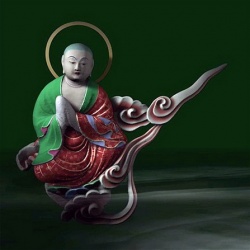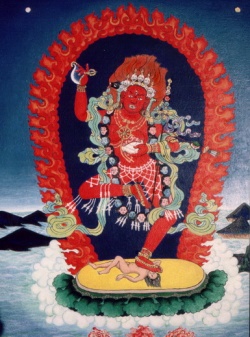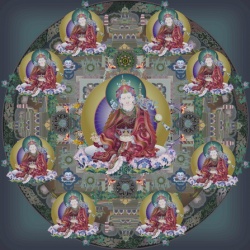Padmasambhava’s Travel to the North
Isabelle Charleux. Padmasambhava’s Travel to the North: The Pilgrimage to the Monastery
of the Caves and the Old Schools of Tibetan Buddhism in Mongolia. Central Asiatic Journal,
Harrassowitz Verlag, 2002, 46 (2), pp.168-232. <halshs-00006195>
HAL is a multi-disciplinary open access archive for the deposit and dissemination of scientific research documents, whether they are published or not. The documents may come from teaching and research institutions in France or abroad, or from public or private research centers. L’archive ouverte pluridisciplinaire HAL, est destin´ee au d´epˆot et `a la diffusion de documents scientifiques de niveau recherche, publi´es ou non, ´emanant des ´etablissements d’enseignement et de recherche fran¸cais ou ´etrangers, des laboratoires publics ou priv´es.
Isabelle Charleux, « Padmasambhava’s Travel to the North » — Author’s own file, not the published version
Please see the published version in Central Asiatic Journal 46 (2002) 2, p. 168-232 Padmasambhava’s Travel to the North:
The Pilgrimage to the Monastery of the Caves and the Old Schools of Tibetan Buddhism in Mongolia1
Isabelle Charleux
CNRS, Groupe Religions, Sociétés, Laïcités Paris, France
In the late 16th century, the ascendant Gelugpa (dGe lugs pa) school of Tibetan Buddhism, founded by the reformer Tsong kha pa (1357-1419), took a firm hold in Mongolia.
With the support of various Mongol qans and, from the 17th century
onwards, the patronage of the Manchu dynasty, the Gelugpas gained a
quasi-monopoly over Mongolia and the Tibeto-Mongol monasteries of China proper.
The other schools, such as the Sakyapas (Sa skya pa), the Karmapas (Karma pa), or the
Nyingmapas (rNying ma pa) seem to have vanished, overwhelmed by the progression
of the Gelugpa “orthodoxy”. It is thus commonly known that Mongolia has been, since
the mid-17th century, a Gelugpa stronghold.
Another particularity of the Mongol Buddhist institution was its dependence on
the great Tibetan and Chinese centres of Tibetan Buddhism: the highest academic
degrees could only be obtained in Kumbum (sKu ’bum) and Labrang (Bla brang)
monasteries in Amdo (A mdo), Beijing and Lhasa. Not only members of the religious
elite, but also ordinary devotees had to travel beyond the Mongol sphere in order to
further their religious practice.
Rather than developing important pilgrimage sites at home the Mongols preferred to visit Wutai Shan in China (Shanxi) or the famous monasteries or sacred sites of Tibet, especially Kumbum and the holy city of Lhasa.3 This was not owing to any lack of interest on the part of Tibeto-Mongol Buddhism in the creation of sacred places in the territory it “conquered”. On the contrary, the importance of local pilgrimages is a common feature of the whole Tibetan Buddhist world. Over the last millennium, an extensive Buddhist pilgrimage network has developed throughout Tibet and the Himalayan border regions under its cultural influence. Mongolia thus appears as an exception in the Tibetan Buddhist cultural sphere.
In the summer of 1995, I undertook fieldwork in the western part of Southern Mongolia during which I visited the most renowned monasteries in Alashan Left banner, a region inhabited by Western Mongols whose aristocracy descended from Güsri qan (1582-1654) of the Qoshud.4
As there was no public transportation available to cross the Yellow River and enter the Ordos league, I followed the Yellow River northwards, to Dengkou City. Having no permit to remain in Dengkou, I was approached by a courteous police officer who tried to prevent me from leaving town.
However, he also informed me that a biennial festival was to take place at the nearby monastery, Aγui-yin süme.
Hundreds of people from the town were going to attend and he himself was going in a bus chartered by the official in charge of the religious affairs of Dengkou. I managed to join the party and was thus able to witness the one-day festival, which eventually lead me to question the notion that local pilgrimages are non-existent in Mongolian Buddhism. I reached the site of the festival, a small temple in an impressive barren mountain valley, after a rough three-hour bus ride.
Aγui-yin süme, “the Temple/Monastery of the caves”, is not only one of the thousand monasteries that flourished in Mongolia during the 18th and 19th centuries; it is also reputed to be “the only” Nyingmapa monastery of this period in Southern Mongolia. The place therefore presented a double interest since it raised both the historical question of minority schools in Mongolia and the more ethnographic one of pilgrimage.
Although I am an art historian and not an anthropologist, I could not ignore the particular circumstances under which I visited Aγui-yin süme. The buildings of the monastery were completely destroyed during the Cultural Revolution: their reconstruction, although of some interest is not the subject of the present study.
My aim here is to examine the special status of this temple within Mongolian Buddhism and to question both its supposed peculiarities.
Due to the scarcity of historical sources on this monastery and the limited time I was allowed to spend there, I can only give a brief description of the legend and history of the monastery and its caves, which will serve as an introduction to the broader issues of pilgrimages and the presence of Nyingmapa order in Mongolia.
I- THE MONASTERY: LEGEND, HISTORY AND PRESENT SITUATION
The Foundation Legend
Aγui-yin süme was sacked in the nineteen-thirties, and a part of its archives were stolen; the remaining archives were destroyed during the Cultural Revolution. The most precise source available is an article by Bai Shenghua (1986), a local historian who collected oral traditions on the monastery, and gathered information from local gazetteers.
According to the foundation legend, Aγui-yin süme was established by a disciple of Padmasambhava or by Padmasambhava himself, the renowned yogin reputed to have introduced Tantric Buddhism in Tibet and revered by the Nyingmapas as a second Buddha. Padmasambhava is said to have left Tibet for China with a retinue, to have visited Luoyang and the sacred Wutai mountain, and to have stopped on his way back to U rgyan (Oddiyâna, localised in Swât valley, Pakistan), at the site of Aγui-yin süme on the 22nd day of the 9th lunar month, 774 AD. There, Padmasambhava met five young dâkinî sisters (Tib. mkha’ ’gro ma), each dwelling in a different cave.
He engaged in tantric practice with each one of them in turn during nine months and twenty-five days. He is also said to have subdued a local demon that terrorised the people and to have locked him up inside the main cave. Padmasambhava left a print of his left foot below the Hongyang cave, and one of the dâkinî left a footprint in front of the Cave of Târâ.
Before leaving, Padmasambhava made a statue of himself (2 chi 5cun -around 70 cm- high) with his own hands. According to his own words, to behold the image is like beholding Padmasambhava himself and the image will protect one against evil spells and demons. The image was also intended to dissuade the demon from reappearing (Bai Shenghua 1986: 123).
Then Padmasambhava took as a disciple the child of a couple living in the caves named “luoben (*slob dpon, teacher) Zandari”.
On the 10th day of the 7th lunar month, 775, he left the site followed by his disciple, his retinue and a crowd of believers from the surrounding areas. He took “Zandari” back to India or to Oddiâna to further initiate him in tantric practice and teachings. Several years later, the disciple returned to Alashan and founded near the caves the Aγui-yin süme, also known as Loboncimbu süme (*Slob dpon chen po), the “Monastery of Padmasambhava”.
Many hermits and wandering monks followed his example and meditated in these caves, attracting devotees and donations.
Source
http://padmasambhavagururinpoche.com/padmasambhavas-travel-north/




